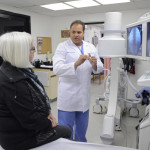What is Migraine?
According to the World Health Organization, severe headaches are top 20 among all disability-causing diseases worldwide. Approximately 45 million Americans suffer from chronic headaches, and of them, about 30 million suffer from migraines. A Migraine is a chronic neurological disorder, a common type of headache that occurs with accompanying symptoms such as intense throbbing or pulsing sensations, nausea, vomiting, and severe sensitivity to sound and light. Migraine victims have been known to experience symptoms for days which prevent them from doing daily activities. Migraines are so severe, that often times victims experience problems with relationships, depression, and even thoughts of suicide.
There are two types of head-pain classifications: Primary and Secondary headaches.
Primary Headaches Include: migraine, tension, and cluster headaches, as well as several other less common types. Primary headaches usually first start when people are between 20 and 40 years old. Most experts have identified that primary headaches are caused by a combination of vascular and neurological disorders in the head and neck. Genetics and environmental causes also contribute to migraines.
Secondary Headaches: Stem from underlying causes related to structural or functional disorders in the head or neck. Numerous causes that could be responsible for this type of headache range from bleeding in the brain, aneurism, tumors, meningitis and encephalitis.
Causes of Primary and Secondary Headaches:
- Stress
- Hunger
- Fatigue
- Bright lights
- Drinking alcohol
- Loud noises
- Neck and spine pain
- Certain odors or perfumes
- Hormonal changes
- Certain foods
- Vasoconstriction
- Excessive visual input
- Neurologic disorders
- Allergic reactions
- Disrupted sleep patterns
- Exercise
Although conclusive underlining causes of migraines are still a topic of research, all of the above are known common triggers of head-pain.
Symptoms associated with primary and secondary headaches:
- Pulsating pain
- Loss of appetite
- Pain localized to one side of head (hemicranial)
- Numbness, tingling, weakness
- Facial pain (trigeminal neuralgia)
- Sweating
- Chills
- Fatigue
Causes and Symptoms of Migraines:
Genetic factors and environmental surroundings could play a role in causing migraines. Migraine headaches often begin in childhood through early adulthood. The onset of a migraine can be caused by changes in interaction between the brainstem and pain pathways (such as the trigeminal nerve). Chemical imbalances in the brain lead to drops in serotonin (chemical which helps regulate pain). Low levels of serotonin are subsequently overpowered by neuropeptides sent to the outer part of the brain resulting in a headache.
Stages of a Migraine Attack:
The four main stages of a migraine attack are prodrome, aura, headache, and postdrome. *You may not experience all of the following stages:
Prodrome: Occurs one to two days before an ensuing migraine. Warning signals include:
- Constipation
- Depression
- Diarrhea
- Neck stiffness
- Food cravings
- Hyperactivity
- Irritability
- Repetitive yawning
Aura: Approximately one-third of people who suffer migraines perceive an aura. Auras are usually visual but can also be sensory, motor or verbal disturbances. Each of these symptoms typically begins gradually, builds up over several minutes, and commonly lasts for 10 to 30 minutes. Examples of aura include:
- Visual phenomena, bright spots, light flashes
- Vision loss
- Pins and needles sensations in an arm or leg
- Speech or language problems
- Aphasia or limb weakness (hemiplegic migraine)
Attack: When untreated, a migraine typically lasts from four to 72 hours, but the frequency with which headaches occur varies from person to person. You may have migraines several times a month or much less frequently. During a migraine, you may experience some of the following symptoms:
- Pain on one side of your head
- Pulsating, throbbing pain
- Sensitivity to light, sounds and sometimes smells
- Nausea and vomiting
- Blurred vision
- Diarrhea
- Lightheadedness, sometimes followed by fainting
Postdrome: The final phase occurs after a migraine attack, when you may feel drained and washed out, though some people report feeling mildly euphoric. Common Conditions: Migraine Headache The Migraine Headache ranks second in the most common type of headache. Many people attribute any type of recurring severe headache to Migraine, regardless of whether or not they have been diagnosed with Migraine Headaches. Symptoms include moderate to severe pain, sensitivity to light, noises or odors, blurred vision, nausea or vomiting, stomach upset, abdominal pain, loss of appetite, sensations of warm or cold, paleness, fatigue, dizziness, and can shift from one side to the other or encompass the whole head. Tension Headache Tension Headaches are the most common type of Primary Headache, characterized by pain that wraps around the head and causing pressure. These headaches are commonly caused by stress, as well as noises and bright lights. Most people experiencing Tension Headaches will notice increasing intensity with time as well as pain originating in the back of the head (Occipital region), moving to the front of the head. Other notable causes include interrupted sleep cycles and depression. Cluster Headache The Cluster Headache is often received in a cyclical fashion. Affecting men more frequently than women, these headaches will come in waves and display increasing intensity with each “cluster.” Pain is often felt behind the eyes and sinuses. New Daily Persistent Headache (NDPH) These headaches are chronic with a daily onset, and unremitting in nature. They usually manifest themselves at areas on both sides of the head (bilateral) and may be unremitting from onset or rapidly build up to continuous unremitting pain. Intractable Migraines Similar to chronic daily headache, Intractable Migraines are severe in nature and typically do not respond to conventional methods of treatment. Occipital Neuralgia Chronic pain in the upper neck, back of the head, and behind the eyes. Pain originates from the lesser and Greater Occipital Nerves in the back of the head and upper neck. This condition most often manifests itself in the form of chronic headaches in the back of the head and around or over the top of the head. The cause of this condition is attributed to damage of the Lesser and Greater Occipital Nerves and is commonly treated by nerve blocks, injections, or peripheral nerve stimulation. Supraorbital Neuralgia Much like Occipital Neuralgia, this condition is caused by damage or abnormal function of the Supraorbital Nerves, located just above each eye. Pain is localized to the lower forehead, but may include areas of the upper forehead and scalp. Chronic headaches are often a result of this condition, which can be treated by nerve blocks, injections, or peripheral nerve stimulation, among others. Chronic Pain Syndromes Chronic pain syndromes of the head and neck can result in severe chronic headaches. These headaches, which have underlying vascular or neurological causes, are often misdiagnosed as Tension, Cluster, or Migraine Headaches. Reflex Sympathetic Dystrophy (RSD) Also called Complex Regional Pain Syndrome (CRPS), RSD is characterized by intense chronic pain that is not in proportion to the apparent injury which caused the disorder. Pain associated with RSD usually gets worse over time. Causes of RSD are unclear. Complex Regional Pain Syndrome (CRPS) Also called Reflex Sympathetic Dystrophy (RSD), CRPS is characterized by intense chronic pain that is not in proportion to the apparent injury which caused the disorder. Pain associated with CRPS usually gets worse over time. Causes of CRPS are unclear. Neuropathic Pain of the Head Neuropathic Pain is a result of a disorder contained in the nervous system and is often chronic. Trigeminal Neuralgia, a type of Neuropathic Pain, has a sudden and intense onset, with sharp, shooting pain in areas of the head and neck. There are usually specific triggers for this type of pain. Patients are unable to perform simple everyday activities for fear of triggering the onset of pain. Acute Headaches Headache with a sudden, rapid onset with intense or severe pain. Often last a relatively short period of time, but can be frequent. Many types of headaches can be considered acute, based on their attributes and duration. Although short-lived, Acute Headaches can affect quality of life. Trigeminal Neuralgia A type of Neuropathic pain, Trigeminal Neuralgia is a result of a disorder contained in the nervous system and is often chronic. It has a sudden and intense onset, with sharp, shooting pain in areas of the head and neck. There are usually specific triggers for this type of pain. Patients are unable to perform simple everyday activities for fear of triggering the onset of pain. What we treat: Our typical patient experiences frequent, severe, and often disabling head pain that has not responded adequately to other more conservative treatments. Physicians at Kill Migraine can treat most types of severe headaches and almost any kind of severe head pain that occurs on a consistent and frequent basis including:
- Migraine headaches with or without aura
- Tension headaches
- Cluster headaches
- New Daily Persistent Headaches (NDPH)
- Persistent Headaches
- Intractable Migraines
- Occipital Neuralgia
- Supraorbital Neuralgia
- Chronic Pain Syndromes, including Reflex Sympathetic Dystrophy (RSD) and Complex Regional Pain Syndrome (CRPS)
- Neuropathic Pain of the Head
- Acute Headaches
- Neuralgia
Next Steps: Call Us Today Our staff is happy to take your call to discuss treatment options, answer any questions, and help schedule your next appointment 1-855-4KILLPAIN (454-5572) Submit Your Question Online Are you at work and don’t have time for a phone call? Submit your question online and we will get back to you with the answer! Sign up for a free migraine seminar: To better help our new patients, KillMigraine hosts free migraine seminars throughout the year. As migraine pain management specialists, we know how complex pain conditions and treatments can be – and how difficult it can be for patients to sift through all of their options. For this reason, our seminars are designed as a relaxed setting where patients can learn about our revolutionary procedure and be better informed to make important healthcare decisions. We invite you to attend one of our free migraine seminars to:
- Learn about the procedure
- Talk with a pain management physician
- Ask questions that concern you
- Talk with other migraine sufferers
- Schedule a private consultation
Take your first step to control the migraine pain and get your life back. Initial Evaluation If you have been through a long list of treatments and are ready to see the doctor, call us to schedule an evaluation today. 1-855-4KILLPAIN (454-5572) Step-by-step process:
- Attend Patient Seminar
- Initial Evaluation
- Insurance Pre-Cert
- Trial Stimulator
- Insurance Pre-Cert
- Permanent Stimulator
Insurance: Certain treatments may require pre-authorization from the insurance carrier to tdetermine twhether the treatment is medically necessary. Your insurance carrier will determine your level of benefits, based on your policy and medical history. This process can take a couple of weeks and will require:
- Examination of your medical history
- History of pain treatments to date
- Psychological evaluation
Our goal is to help you get relief from migraine pain as soon as possible. We will make every effort to provide insurance support that is quick and convenient for you.


